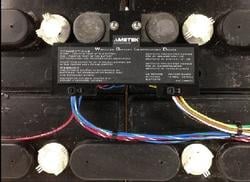
Ametek Prostolite Power launches wireless battery identification device
AMETEK Prestolite Power began shipping an advanced Wireless Battery Identification Device (WBID) that continually reads and stores information about lift truck batteries. It also announced major updates to DataLink 2, its data analysis software used in conjunction with WBIDs and battery Charger Interface Devices (CIDs). Working together, the WBID and DataLink 2 are designed to improve warehouse efficiency by gathering data wirelessly, monitoring battery usage and identifying potential problems that could lead to downtime.
The new WBIDs provide critical information to extend battery life, solve service issues and help with warranty claims, according to AMETEK Prestolite Power Director Patrick Williams. Motive power batteries can be more easily monitored for voltage, temperature and amp-hour usage using the battery identification device number, voltages, amp-hour sizes and start rates.
Williams said the latest competitive advantages to the new WBIDs include:
• Six multi-purpose input/output channels to adapt to multiple temperature and level measurements or LED indicators as needed in the application.
• All collected data can be stored over the total life of the battery.
• Data communication to the charger can be done over the DC cable without special or auxiliary connectors.
• For the first time only one WBID is required for 12-40 cell sizes.
• When working together, the WBID and DataLink 2 software will adjust the amp-hour to ensure that charging does not overheat the battery.
“Our chargers enable ‘opportunity charging,’” he added, “the concept of leveraging a forklift operator’s break time to recharge battery power and wirelessly report on efficiency, existing power and other key parameters that help a warehouse run smoothly with reduced downtime and significantly less space.”
AMETEK’s DataLink 2 software, working in conjunction with the WBIDs and CID, greatly enhances the ability to collect, charge and discharge data from the charger. Updates include a new “kinetic” analyzer tool to import, evaluate and report on data from a WBID. Users can use the data to compare the status of one battery to another for usage, temperature and current.
DataLink 2 and the WBID wireless fleet management system transfers data over the company’s proprietary wireless network that uses a powerful transceiver. Williams said the system doubles the typical communication range between chargers from 1500 feet to 3,000 feet in a normal operating environment. He added that the software is compatible with the company’s most advanced charger controls – the EC2000 for high frequency products, the UC2000 and SCR2000 for SCR products, and the AC2000 for Ferroresonant product lines — and with Microsoft Windows Vista, 7 and XP operating systems.
“By leveraging our technology and taking advantage of the competitive advantages we have in the market with advanced WBIDs, opportunity charging and more, we are setting ourselves apart as a clear leader in battery charging technology,” Williams said.









